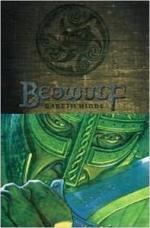|
This section contains 1,057 words (approx. 4 pages at 300 words per page) |

|
Beowulf: Use of Juxtaposition to Suggest a Subtext
Juxtaposition is a literary device that allows an author to reveal a subtext by placing certain events in close relation to each other. In Beowulf, the poets skillfully use juxtaposition to suggest a subtext that ridicules the Germanic warrior's misplaced love of treasure, the bestiality, futility, and wastefulness of feuding, and, finally, in Beowulf's last fight, the failure and dissolution of the comitatus.
To the Germanic warriors the possession of treasure such as gold, silver, famous swords, and helmets symbolized loyalty, allegiance and protection. The Beowulf poets show the reader that the warriors' value of treasure is misguided by first skillfully mentioning treasure, in detail, at times that make it seem worthless such as burial and death. When discussing Shild's burial, the poet notes that his men "heaped up treasures, jeweled helmets, hooked swords, and coats of mail, armor...
|
This section contains 1,057 words (approx. 4 pages at 300 words per page) |

|


